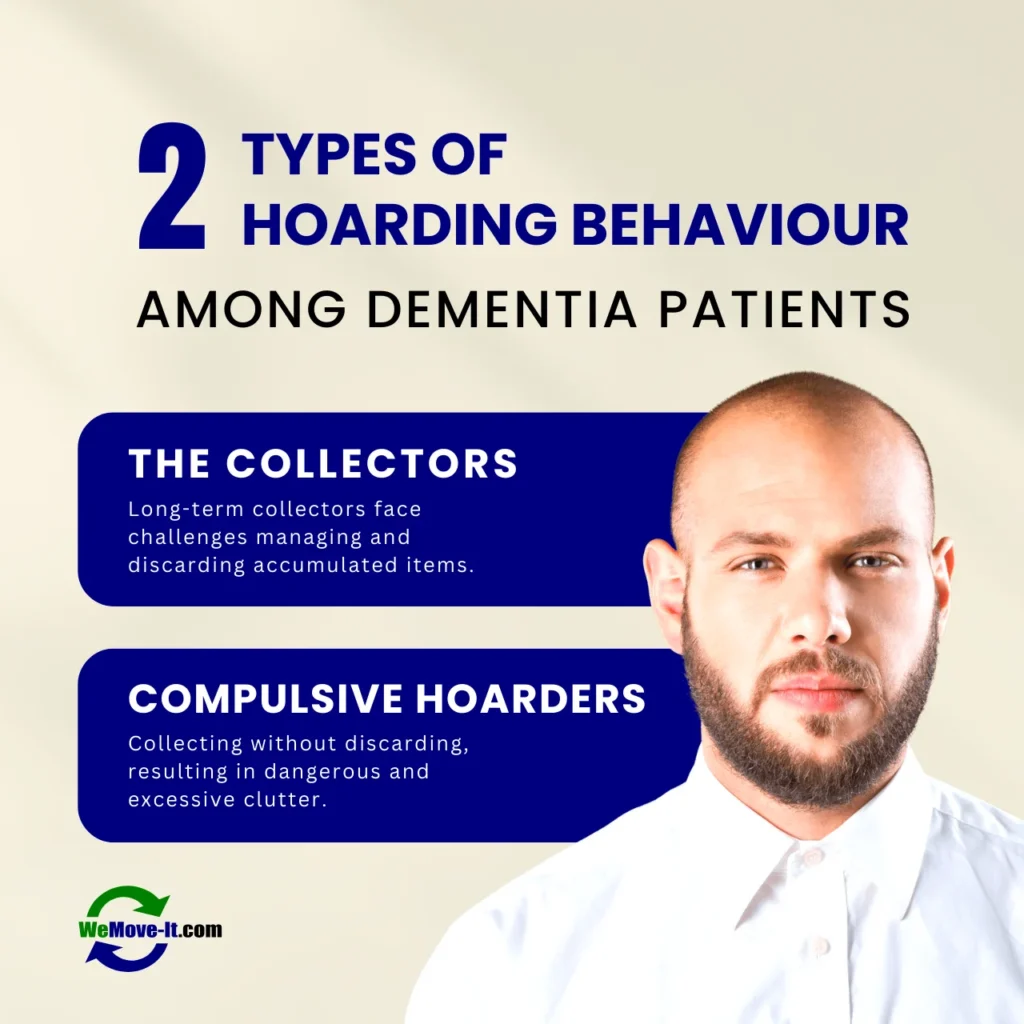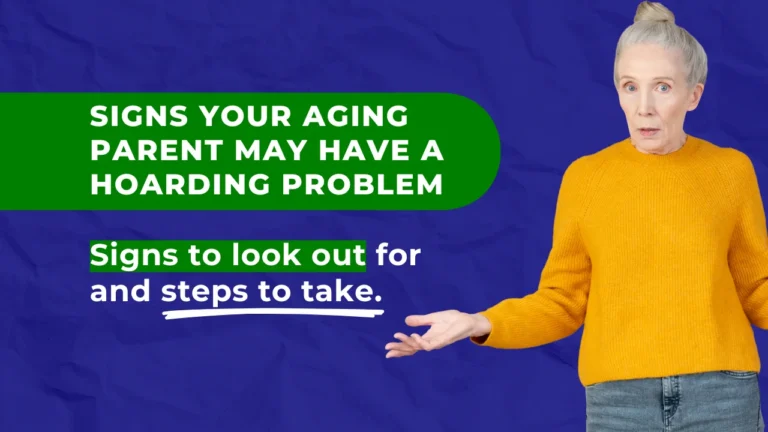Dementia is a group of conditions that affect memory, thinking, and the ability to perform everyday activities. While Alzheimer’s disease is the most common type, there are others like vascular dementia and Lewy body dementia. Symptoms can include memory loss, getting confused easily, changes in mood and behaviour, and even hoarding behaviours.
Hoarding disorder and dementia are two challenging conditions that can significantly affect an elderly person’s life, and recent research suggests that there might be a link between the two. In this article, we take a closer look at the correlation and how you can help a loved one who may be affected by both.
How Are Dementia and Hoarding Connected?
According to the Alzheimer Society of Canada, there is a marked correlation between dementia and hoarding. This connection can be attributed to various cognitive, emotional, and neurological factors that influence both conditions, and understanding them can help you better support elderly loved ones who may be affected by both.
Cognitive Issues and Hoarding

Cognitive decline, which is a major aspect of dementia, impacts a person’s ability to think clearly and make sound decisions. This can lead to hoarding behaviours in several ways:
- Memory Loss: Those with dementia may forget why they own certain items or where they have stored them. This often results in repeatedly acquiring similar items, which in turn leads to unnecessary accumulation.
- Decision-Making Difficulties: Dementia can impair a person’s ability to make decisions about what to keep and what to discard. This indecision can result in holding onto items that others might see as useless or redundant.
- Organizational Challenges: Dementia can also make it hard for seniors to properly organize their belongings. The lack of organization can quickly lead to clutter, making living spaces unsafe and hard to navigate.
- Perceived Need: People with dementia might feel an exaggerated need to keep items “just in case” they might be useful in the future, even if these items have no practical value.
Emotional Factors
Emotional changes are another aspect of dementia that can exacerbate hoarding behaviours. Some of the emotional factors include:
- Anxiety: Individuals with dementia often experience heightened anxiety, which can manifest as a need to hold onto possessions. This anxiety may stem from a fear of losing control or feeling insecure.
- Depression: Depression, which is common in dementia, can create a lack of motivation to clean or organize, resulting in clutter. The accumulation of items may serve as a coping mechanism to fill an emotional void.
- Attachment to Items: Dementia can cause people to form strong emotional attachments to their possessions and view them as sources of comfort and stability in a world that feels more and more confusing and unpredictable.
- Sense of Loss: As cognitive abilities decline, individuals may cling to their belongings as a way to maintain a connection to their past and preserve memories.
Neurological Factors

The neurological changes associated with dementia also contribute to hoarding behaviors. These changes include:
- Frontal Lobe Dysfunction: The frontal lobes of the brain, which are responsible for decision-making, planning, and regulating behavior, are often affected in dementia. Dysfunction in this area can lead to impaired judgment and impulse control, both of which are associated with hoarding.
- Temporal Lobe Changes: The temporal lobes play a key role in processing memories. Damage to these areas can result in difficulty recognizing the significance of items or remembering past decisions about them, contributing to hoarding behaviors.
- Parietal Lobe Involvement: The parietal lobes help us understand spatial relationships and navigate our environment. When these lobes are affected, individuals may struggle to recognize the extent of their clutter or understand how it impacts their living space.
Types of Hoarding Behaviour Among Dementia Patients

Understanding the different types of hoarding behavior can provide further insight into how dementia influences these actions.
- The Collectors: Some people naturally accumulate collections of items that hold personal significance. These individuals may have always been collectors, and as dementia progresses, their ability to manage these collections diminishes, leading to excessive accumulation and difficulty discarding items.
- Compulsive Hoarding: This type of hoarding involves a specific pattern of behavior where the person collects multiple items they are unable to discard. Over time, their living areas become cluttered, unsafe, and pose health risks.
Hoarding for individuals with dementia often stems from their need to exert control over their lives. Since hoarding tends to happen in the early and middle stages of dementia, this need to hold onto items can be a way for them to cope with their deteriorating memory and cognitive functions.
How to Manage Hoarding in Dementia
Handling hoarding in someone with dementia requires patience, empathy, and a thoughtful approach. Here are some strategies that can help you and other caregivers manage and reduce the hoarding behaviours.
Create a Safe Environment
- Remove Hazards: Identify and eliminate any potential safety hazards such as fire risks and clutter blocking exits. Make sure that pathways are clear and that essential items are easily accessible.
- Organize Essentials: Organize and label essential items in a way that makes sense to the person with dementia. Using clear bins and labels can help reduce confusion and make it easier for them to find what they need.
- Simplify the Environment: Minimize unnecessary furniture and decorations to reduce sensory overload and make the living space more manageable. Keeping the environment simple can help reduce anxiety and improve safety.
Get Professional Help
- Doctors: A primary care physician can assess the individual’s overall health and identify any medical issues contributing to hoarding behaviours. They can also provide referrals to specialists if needed.
- Psychologists: Mental health professionals can offer therapy to address the emotional aspects of hoarding and dementia. They can help the person with dementia develop healthier coping mechanisms.
- Occupational Therapists: Occupational therapists can work with dementia patients to develop practical strategies for daily living. They can assist with organizing tasks, creating routines, and making the home environment more functional.
Declutter Gradually
- Start Small: Begin with areas that are less emotionally charged, such as the bathroom or kitchen. Refrain from starting with personal items that might have high sentimental value.
- Involve the Person: Engage thm in the decluttering process as much as possible. Ask for their input and respect their decisions. This can help reduce resistance and make the process feel collaborative.
- Set Small Goals: Break down the decluttering process into small, manageable tasks. Set realistic goals for each session and celebrate progress, no matter how small.
Cognitive Behavioural Therapy (CBT)
- Simplify Tasks: CBT can be an effective tool in treating hoarding disorder. This is because it breaks down important tasks into simpler steps that the person can easily follow. For individuals with dementia, CBT techniques can be adapted to their cognitive abilities..
- Use Visual Aids: Visual aids, such as charts and diagrams, can help reinforce CBT concepts and provide reminders of coping strategies.
- Regular Practice: Consistent and regular practice of CBT techniques can help reinforce positive behaviours and reduce hoarding tendencies.
Additional Strategies
Beyond the primary approaches, there are other strategies that can support managing hoarding in dementia.
- Establish Routines: Creating and maintaining daily routines can provide a sense of structure and predictability. Routines can help reduce anxiety and make it easier to manage daily tasks.
- Provide Emotional Support: Offer emotional support and reassurance. Understand that hoarding behaviours may be a response to feelings of insecurity and loss. Compassion and patience are key.
- Monitor Progress: Regularly assess the living environment and the person’s behaviour. Adjust strategies as needed to address new challenges or behavioural changes.
- Use Technology: Consider using technology to assist with organization and safety. For example, medication reminders, digital calendars, and tracking devices can help manage daily tasks and reduce anxiety.
Conclusion
Understanding the link between dementia and hoarding can help you provide better care as well as improve the quality of life for those affected. While it can be challenging, it is important to approach this situation with patience, empathy, and a commitment to providing the best possible care and support.For those in the Greater Hamilton Area, WeMove-It.com offers specialized hoarder clean out services. Our team can sort and save items, remove unwanted property, and perform deep cleaning and restoration. By providing confidential and compassionate support, we keep hoarding remediation is manageable and respectful. Contact us today for a free estimate and let our professional team make your loved one’s space livable and functional again.



